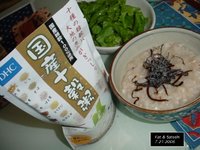My impression of kiriboshi daikon isn't a very good one. Most times when you get it at the sozai-ya (pre-made food shop) or when it is in a bento, the daikon is limp, not a very nice texture.
On top of that, the color is brown because it is simmered in shoyu (soy sauce) and other ingredients.
So, when I spotted this colorful salad in Roca's book, I had to try it.
I'd never cooked with kiriboshi daikon, so using this was a first for me.
Kiriboshi daikon is daikon that is sliced and then dried. These days a lot of housewives are cutting and drying their own veggies. By drying them, the veggies are supposed to retain a lot of their nutrients as well as a lot of their flavor.
I also think that by drying them, you can keep them in your pantry for off-season cooking.
When I opened the package of kiriboshi daikon, the aroma of daikon was really strong. The texture looked like the paper that gets stuck in the shredder...
Kiriboshi Daikon Mustard Salad from "Roca no Teishoku" : serves 2
20 grams kiriboshi daikon
hot water
2 teaspoons shoyu (soy sauce)
1.5 tablespoons vinegar
25 grams onion (about 1/8 of an onion)
15 grams red cabbage (about 1 leaf)
20 grams carrot (about 3 centimeters)
30 grams Japanese cucumber (about 1/3 of a cucumber)
1/2 teaspoon salt
1 tablespoon mayonnaise or your favorite oil
grainy mustard
Rinse the kiriboshi daikon and then pour enough hot water over it to cover it and let it rehydrate.
Let it sit for at least 20 minutes.
While you are waiting for the daikon to rehydrate, get the rest of the salad ready.
Thinly slice the onion, cabbage and cucumber.
Julienne the carrot.
In a container, put the onion, cabbage, cucumber and carrot.
Sprinkle the salt, mix with your hands and let sit.
After 20 minutes, drain the water from the daikon and squeeze gently (you don't want it totally dry).
While the daikon is still warm, add the shoyu and vinegar, mix and let cool.
After about 30 minutes to an hour, the daikon should be cooled and the other veggies will have released some of their water.
Drain the water from the veggies.
Add the daikon with its "sauce" to the veggies.
Add a little grainy mustard, I used about 1/2 teaspoon, and the mayo.
Mix well and then chill.
NOTES: The daikon is so crunchy! In fact, everything in this salad is. We enjoyed this several times already. I am definitely making this again!






















.JPG)








